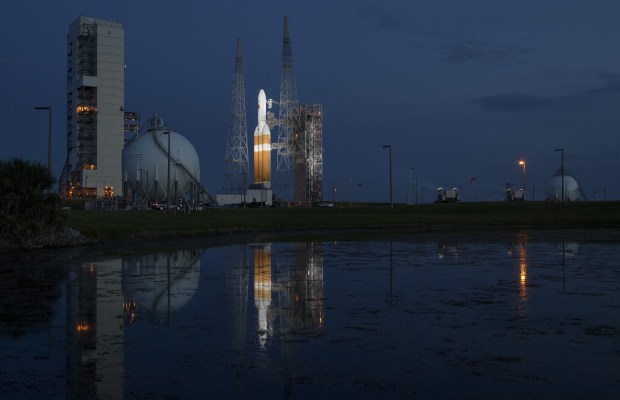While Earthlings were wrapping gifts and preparing holiday buffets this past Christmas Eve, a rocket named for a south suburban Chicago man was “touching” the sun.
Traveling at “a blazing 430,000 miles per hour,” according to NASA, the Parker Solar Probe became the first spacecraft to reach the outer corona of the sun.
If only its namesake, Eugene Parker, had lived to celebrate it.
Parker, a renowned south suburban astrophysicist, died in 2022, three years after he watched the rocket bearing his name, and boosted by his 1958 theory on solar wind, launch from Cape Canaveral in Florida. Destination: The sun.
According to NASA, a beacon tone received on Dec. 26 “confirmed the spacecraft had made it through the encounter safely and is operating normally.
“This pass, the first of more to come at this distance, allows the spacecraft to conduct unrivaled scientific measurements with the potential to change our understanding of the sun,” NASA states at science.nasa.gov/science-research/heliophysics/nasas-parker-solar-probe-makes-history-with-closest-pass-to-sun.
I first met Parker in 2017, during a presentation he was giving at the Izaak Walton Preserve in Homewood.
At age 90, the University of Chicago emeritus professor stood demurely before an audience of local teachers, plumbers, children and housewives explaining complex diagrams and math equations on an overhead projector.
No doubt his theory on the solar wind soared above the heads of everyone in attendance, myself included, but in astrophysics circles it was, and continues to be, hailed as genius.
The United Launch Alliance Delta IV Heavy rocket with the Parker Solar Probe onboard is seen at Cape Canaveral Air Force Station in Florida on on Aug. 10, 2018. (NASA /Bill Ingalls)
The theory led to Parker becoming the first living person to have a NASA rocket named for him.
But the path to cosmic stardom is often littered with space junk.
Early in his career, Parker was criticized, even ridiculed, for his proposal on the theory of solar wind, which he built through his observation that a comet’s tail always points away from the sun. Though his work was published, he endured doubters.
“Whenever you have a good idea, it’s inevitable some people will criticize it and deny it. Some people will try to prove it’s wrong,” he told me during a phone interview days after his presentation. “That was no surprise. That doesn’t mean it wasn’t annoying, though.”
Parker spoke in layman’s terms, even recalling a response he gave to critics: “Solve the goddamn equation.”
A sketch of a comet orbiting the sun debunked the common assumption that the tail always follows behind, he said.
“Your instinct tells you it’s moving this way and that the tail is behind. But the interesting thing is it doesn’t work that way. The tail of the comet always points straight away from the sun, in antisolar direction. Sometimes the tail trails behind but sometimes it’s perpendicular, and sometimes it’s ahead of the comet like a headlight on a railroad locomotive,” he said.
“People said, ‘That’s impossible.’ But since it happens it evidently is not impossible,” he said.
By 1962, “people were totally skeptical,” he said, even as NASA’s Jet Propulsion Laboratory launched Mariner II, en route to Venus.
“That (rocket) carried a fairly sophisticated plasma reader that just happened to record the solar wind from the time they got out of the magnetic field of Earth until they got to Venus,” he said. “So, there was a solar wind and the arguments and criticisms stopped. That was the end of the negative part. And then people picked it up and elaborated on it.
“There was a lot to learn about it,” he said.
In 2018, Parker watched from Cape Canaveral as the Parker Solar Probe blasted off for the outer corona of the sun.
Born in 1927, Parker grew up in Detroit, attended Michigan State University and the California Institute of Technology.
He moved to Chicago after being offered a position at the University of Chicago in 1955. A few years later, he and his wife, Niesje, moved to Park Forest. In 1960, the couple bought a house in Homewood, where they lived and raised their two children until moving to Flossmoor in 2008.
Over the years, Parker served twice as chair of the department of astronomy and astrophysics. His work advancing heliophysics earned him the George Ellery Hale Prize, the Kyoto Prize, the National Medal of Science, the Crafoord Prize and election into the National Academy of Sciences.
But it is his recognition by NASA that has shone around the world.
While Parker enjoyed a celebrity status among scientific minds, south suburbanites say it was his down-to-earth dedication to local causes, to nature and to his neighbors that made him a superstar in their universe.
He wasn’t the first rocket scientist to strike a chord with everyday Earthlings, just like this wasn’t the first Christmas Eve feat to cause us to look toward the heavens.
Some of you may recall Christmas Eve 1968, as Apollo 8 orbited the moon and astronauts Frank Borman, Jim Lovell and Bill Anders sent back beautiful images of Earth as they read from the book of Genesis and wished Earthlings a Merry Christmas.
Brilliance is as brilliance does.
Donna Vickroy is an award-winning reporter, editor and columnist who worked for the Daily Southtown for 38 years. She can be reached at donnavickroy4@gmail.com.





